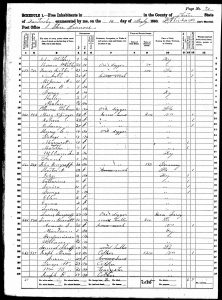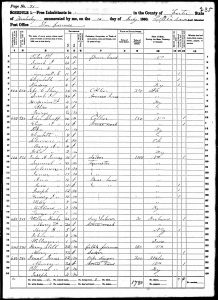How were many families earning a living in 1860 in the Williams Creek Basin (abbreviated WCB)?
In 1860, just before the Civil War, there were only two relatively small population centers in the WCB. One was at Buena Vista Furnace started in 1847,Rist, Iron Furnaces Hanging Rock, p41 and the other was Star Furnace started in 1848.Rist, Iron Furnaces Hanging Rock, p101 The railroad had just made it to Princess in 1857, Coalton in 1858, but it was not yet to Rush (there in 1872).Jackson, Kentucky Encyclopedia, p109 The huge coal mining boom throughout the WCB, beginning at Coalton in about 1865, had yet to develop.
Other than people engaged in operating these furnaces, and the necessary related enterprises to support these small furnace communities making iron, there were only a few farms scattered here and there in the Williams Creek Basin. So that was it, people working at and around Buena Vista Furnace making iron, people working at and around Star Furnace making iron, and a few scattered farms here and there.
In this era both Buena Vista and Star Furnace were using charcoal for fuel. Charcoal was fundamental to make their iron. Star Furnace had a 9333 acre tract of landStarFurnaceMap for the required timber to make charcoal, and Buena Vista had a 6000 acre tract.Rist, Iron Furnaces Hanging Rock, p43
One of the most common jobs associated with a charcoal based furnace was the labor-intensive process of being a “collier” to manufacture the necessary charcoal. The more standard, dictionary definition of a “collier” is someone that works in a coal mine, but on the American Frontier a “collier” was a person that makes charcoal from local timber.
Therefore, many of those earning wages in the WCB in 1860 were likely colliers making charcoal for the Buena Vista and Star Furnaces. The 1860 US Census listed occupations, and there are “colliers” listed at Star Furnace. Below are two sample images from the 1860 US Census from Star Furnace. Note the “colliers” in the “Profession – Occupation” column. Click on the images for a larger and more readable view.


Of particular interest is the collier named Joseph B. Norris on the bottom line of the first page of the 1860 Star Furnace census form above. This 19 year old collier, who actually went by the name of J. Bertrand Norris, also kept a detailed diary for 1861 and 1863. In these diaries he describes his work as a collier, in addition to relating many details of life at Star Furnace. These diaries survive and will be will be the subject of future WCB website articles. J. Bertrand Norris’ Great Grandaughter, Kaye Koontz Jones, has transcribed his 1861 and 1863 diaries. But first, I wanted the readers to have a good understanding of the collier occupation, hence this article.
Being a collier was very hard work and the process required 24-hour attention to efficiently produce the charcoal. The timber was cut locally and the charcoal manufactured relatively close to the cutting location. After it was produced the much lighter and far less bulky charcoal was transported to the furnace site. Other important bulky raw materials used in the charcoal making process like tree leaves, used to seal the ad hoc charcoal hearth, were also readily available on the ground in the forest where the timber was cut.
In 1941 the US Park Service produced an excellent and detailed study, by Jackson Kemper III, on being a collier and making charcoal. This study details the exact process used to manufacture, on site, the charcoal to fuel the furnaces of the American Frontier, like Buena Vista and Star Furnaces. The study was detailed, attended, and supervised by octogenarian, Lafayette Houch. Mr. Houch was one of the last surviving original colliers using this mature charcoal making process and had personally used this exact process years earlier. He kindly, in his 80’s, shared his keen knowledge to preserve the intricacies of the collier’s vocation. This publication is short, only 25 pages, and is rich with photographs (18 total) and even includes the jargon used in this process. It is a very interesting read and I greatly enjoyed it, and it is available free online. Just click on the link below.
Making Charcoal In Depth Study – Collier’s Work – 1941 National Park Service
Here is also a short article with a bullet point listing of the how colliers made charcoal (click on link for article).
Next Article – Star Furnace Visit – Summer 2015
Previous article – The AC&I Mine Ledger for Coalton, KY (1888 – 1889)
